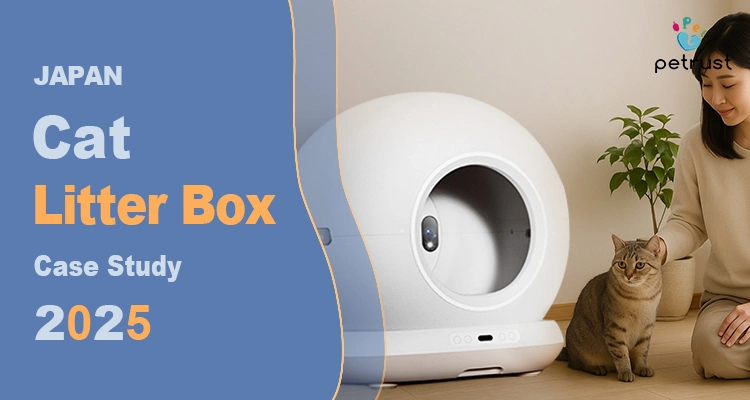Self-cleaning litter box Japan buyers aren’t just looking for automation—they’re looking for quiet, compact, and beautifully designed solutions that truly fit their homes and lifestyles.
In Japan, where space is limited and cleanliness is a cultural value, a bulky, noisy litter box simply won’t make the cut—no matter how “smart” it claims to be. That’s why understanding what works (and what doesn’t) in the Japanese market is crucial for any brand, importer, or OEM partner hoping to succeed.
In this expert 2025 guide, we’ll walk you through what Japanese consumers actually expect from a self-cleaning litter box, which design features win shelf space (and hearts), and how you can build or source a solution that meets both functional and cultural standards—without the guesswork.
Why the Self-Cleaning Litter Box Japan Market Is Growing So Fast
Japan’s bond with cats runs deep—and it’s only getting stronger. As of 2024, there are an estimated 8.8 million cats across the country, and notably, pets now outnumber children under 15 (15.9 million pets vs. 13.7 million kids).
But this growing affection comes with real-life challenges. In a country where the average apartment is just 65㎡, Japanese cat owners are turning to smarter, quieter, and more compact solutions to make daily life easier—for both humans and felines.
That’s where self-cleaning litter box comes in. These devices aren’t just a luxury—they’re becoming a practical necessity. According to Future Market Insights, Japan’s smart litter box market is expected to grow at a 12% CAGR through 2034. Even more specifically, Grand View Research projects the self-cleaning litter box segment to reach USD 36.6 million by 2030, rising from USD 20.1 million in 2024.
Whether you’re a pet brand planning your next product move or a distributor looking to meet demand, now is the right time to understand what makes a litter box truly “Japan-ready.”
For insights on how to choose the right manufacturing partner, explore our Complete Guide to Pet Product Manufacturers in China (2025).
What Works Best for Self-Cleaning Litter Box Japan Buyers
Japanese cat owners don’t just want smart—they want smart that fits. In a market where compact living, quiet environments, and thoughtful design are everyday realities, self-cleaning litter boxes must go far beyond basic automation. Here’s what actually wins trust—and shelf space—in Japan.
Compact Self-Cleaning Litter Box Japan Models That Fit Real Homes
Space is precious in Japan. Most urban apartments don’t have room for bulky Western-style litter boxes. That’s why compact models under 45 cm wide and 40 cm high are the gold standard.
Features that perform best:
- Top-entry or corner-fit structures
- Minimalist designs that blend into the home
- Easy cleaning trays without complex assembly
Curious what else makes a model successful in Japan? See our Top 5 Japanese Litter Box Designs Loved by Cat Owners (2025).
Quiet Self-Cleaning Litter Box Japan Picks for Peaceful Homes
In Japan, noise isn’t just an inconvenience—it’s a deal-breaker. Litter boxes louder than 45 dB are often returned or poorly reviewed. Japanese pet parents are especially sensitive to sound when the litter box is placed in bedrooms or shared living areas.
Top performers include:
- Petrust® CB002, running at <35 dB
- PETKIT PuraMax, praised for silent nighttime cycles
“The first cat litter box I’ve ever used that didn’t wake me up in the middle of the night. Total game changer.” — Cat owner, Tokyo
Learn more in Why Japanese Buyers Prefer Quiet & Compact Cat Litter Boxes.
Smart Self-Cleaning Litter Box Japan Features That Add Daily Value
Japanese consumers are digitally fluent—and they expect their pet products to be, too. Cat Litter box that includes smart features are seeing a sharp rise in popularity, especially when they simplify daily care and provide health insights.
Most-requested features:
- Real-time cleaning notifications
- Cat weight and visit tracking (for early illness detection)
- App-controlled schedules via Tuya Smart or Google Home
- Push reminders for cleaning, deodorizing, and maintenance
These aren’t gimmicks—they’re practical upgrades that give pet parents more control and peace of mind.
What Doesn’t Work in the Self-Cleaning Litter Box Japan Market
When it comes to selling smart litter boxes in Japan, even great products can miss the mark—simply because they weren’t built with Japanese homes or expectations in mind. Here are the most common pitfalls international brands face when entering the Self-Cleaning Litter Box Japan market:
Oversized Units That Just Don’t Fit
Products like the Litter-Robot 4 or Leo’s Loo Too may work well in larger Western homes—but in Japan’s compact apartments, they can be a dealbreaker. Many Japanese pet parents prefer placing litter boxes in small washrooms or tight storage nooks. An oversized model not only feels intrusive—it can also trigger higher shipping costs and customs duties due to its bulk.
Planning your export strategy? Read How to Export Cat Litter Box to Japan: A Step-by-Step Guide.
Too Noisy or Too Much Work
Japanese consumers deeply value quiet living—and so do their cats. Devices with loud motors, frequent clogging, or complicated upkeep tend to get poor reviews on Amazon Japan. If the product can’t blend into everyday life without drawing attention, it won’t last long on the shelf.
What works instead? Whisper-quiet operation, simple maintenance steps, and long-lasting filter systems.
Missing Japan-Specific Power & Labeling
Many imported models fail compliance checks simply because they overlook key local standards. Japan uses 100V power voltage, and all electronics must pass PSE certification. What’s more, products sold in Japan must come with Japanese-language manuals and packaging—no exceptions.
Need help with compliance? Visit our Pet Product Certifications Guide (CE, FCC, FDA) to learn how to meet both global and Japan-specific requirements.
Top-Selling Self-Cleaning Litter Box Japan Products in 2025
If you’re planning to enter the Japanese market or develop your next best-seller, understanding what’s already working is a smart place to start.
Below, we’ve rounded up the most popular self-cleaning litter box Japan models in 2025—each meeting the core expectations of Japanese consumers: compact design, whisper-quiet operation, and intuitive smart features.
| Brand | Size | Noise Level | Key Smart Features | Price (JP¥) |
| Petrust® CB002 | Compact | < 35 dB | App control, multi-cat ID, UV sterilization | Approx. ¥45,000 |
| PETKIT PuraMax | Compact | < 40 dB | App-enabled, health monitoring | Approx. ¥39,800 |
| Neakasa M1 | Medium | Very quiet | Dual-cleaning modes, app sync | Approx. ¥49,800 |
| Leo’s Loo Too | Large | Slightly louder | Built-in camera, voice assistant, app integration | Approx. ¥69,000 |
| Litter-Robot 4 | Bulky | 45 dB+ | AI-driven cleaning, Wi-Fi smart control | Approx. ¥109,000 |
These listings reflect what matters most in Japan: not just functionality, but peace, space efficiency, and seamless technology. If your next product aligns with these qualities, you’re already on the right track.
Curious about how to customize your own model for Japan? Explore in-depth strategies in the Japanese Litter Box OEM Customization Guide for Global Buyers (2025)
A Real-World Win in Japan: How Petrust® Helped a Tokyo Brand Succeed with the CB002
In early 2024, a Tokyo-based pet care brand came to us with a clear goal: they needed a self-cleaning litter box that truly fit the Japanese lifestyle—quiet, compact, elegant, and compliant.
Together, we customized the CB002 smart litter box, fine-tuning everything from size and motor noise to packaging design and PSC compliance. The result?
Real impact within months:
- Return rate dropped by 37% compared to previously imported models like the Litter-Robot
- Achieved “Amazon’s Choice” status in its category—within just 3 months
- Over 60% of customer reviews praised its whisper-quiet operation and space-saving form
This wasn’t just a product launch—it was a tailored, market-fit solution built from mutual understanding.
See how they did it: Cat Litter Box Japan Case Study: How a Tokyo Brand Launched Their OEM Product with Petrust®
How to OEM Your Self‑Cleaning Litter Box for Japan’s Market
Bringing a Self-Cleaning Litter Box Japan model to life isn’t just about smart tech—it’s about aligning with local standards, lifestyle expectations, and consumer trust. If you’re planning to launch in Japan, here’s what your product needs to get right from the start:
Packaging & Labeling Requirements
In Japan, packaging speaks volumes about your brand—and it also speaks legal language. Here’s what matters most:
- Compliance with the Household Goods Labeling Act is non-negotiable.
- All instructions and safety warnings must be in Japanese—clear, culturally appropriate, and easy to follow.
- Clean, minimalist design is preferred for both e-commerce and offline retail. Excess clutter = lost trust.
Explore deeper: Cat Litter Box Packaging for Japan: Legal Requirements & Localization Tips
PSE Compliance for Power Modules
If your litter box uses electricity (and most do), PSE certification is essential. Without it, your product can’t legally enter or be sold in Japan.
- Ensure your device supports 100V voltage.
- The PSE mark must be visible on the power module.
Don’t miss this: Pet Product Factory Audit Checklist: What to Check Before You Order
OEM Support That’s Built for Japan
At Petrust®, we don’t just build products—we help you build Japan-ready solutions. Our OEM services include:
- PSE-certified PCBA & motors
- Fully localized packaging with Japanese labeling
- Mockup visuals tailored for Amazon Japan listings
- Rapid prototyping (5 days) and custom production in just 30 days
Need a head start? Request a Free OEM Mockup for Japan
Learn more about our development process in: Pet Products Manufactured in China: Step-by-Step OEM Production Process
FAQs — Self-Cleaning Litter Boxes in Japan
1. Are self-cleaning litter boxes really popular in Japan?
Absolutely. In cities like Tokyo or Osaka, where every square meter counts and pet owners juggle busy schedules, self-cleaning litter boxes have become a go-to choice. Quiet, compact, and low-maintenance—these smart solutions fit perfectly into modern Japanese lifestyles.
2. Can I import a robot litter box into Japan?
Yes—but not without preparation. Your unit must be compatible with Japan’s 100V voltage and meet PSE certification requirements. Also, keep in mind that Japanese consumers care deeply about aesthetics, size, and even label formatting. Details matter.
3. What’s a good compact option for Japanese homes?
Many Japanese buyers prefer models that combine function with form. The Petrust® CB002, for example, is designed with ultra-quiet operation, minimal footprint, and soft-tone finishes that blend into smaller, design-conscious living spaces.
Final Thoughts — Designing Self-Cleaning Litter Boxes That Truly Fit Japan
The self-cleaning litter box Japan market isn’t just growing—it’s evolving. But growth alone doesn’t guarantee success. In Japan, only products that thoughtfully reflect the way people live—quiet, compact, minimalist, and compliant—earn lasting traction.
If you’re aiming to stand out, design with these in mind:
- Compact homes: Prioritize space-saving form factors
- Quiet living: Reduce noise to respect the calm of Japanese households
- Legal compliance: Ensure your product passes PSE/PSC and other local standards
- Minimalist packaging: Keep the design clean, refined, and shelf-ready
Whether you’re customizing your first prototype or refining a mature product line, understanding these nuances can make the difference between a one-time sale and long-term brand trust.
Still exploring your best approach? Read Pet Product OEM vs ODM Explained: Which Model Fits Your Business
Want to test your concept first? See How to Request and Evaluate Pet Product Samples from China (Like a Pro)







